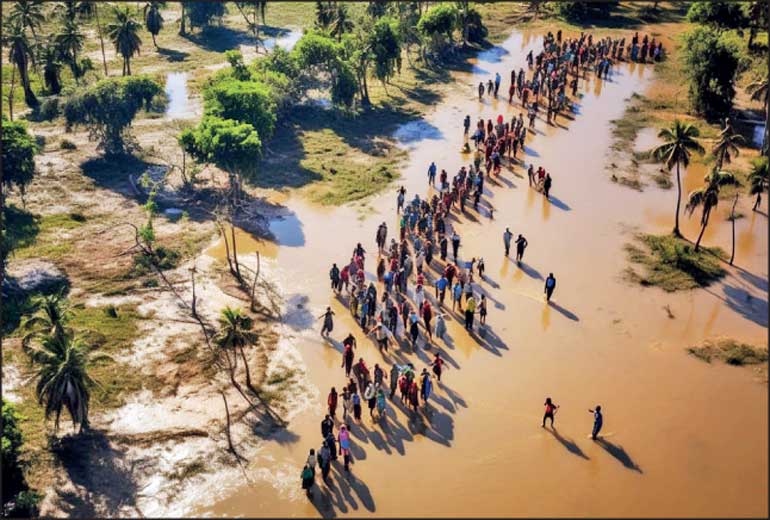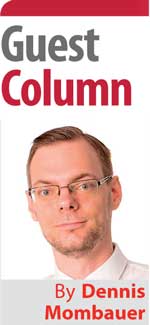Tuesday Apr 22, 2025
Tuesday Apr 22, 2025
Saturday, 18 November 2023 00:10 - - {{hitsCtrl.values.hits}}

It is crucial to understand the present and future patterns of human mobility and how they are shaped by climate change in Sri Lanka and across the world
 The impacts of climate change are increasingly manifest in countries across the world, where they disrupt economies, communities, and lives. Sri Lanka and the South Asian region are among the most vulnerable areas of the world, threatened by extreme weather events as well as long-term processes, such as temperature increase, sea level rise, soil depletion, or degradation of natural ecosystems. In this context of a changing planet, it is crucial to develop a deep and holistic understanding of the patterns of human mobility and how they are shaped or affected by climate change both in the present and in the future.
The impacts of climate change are increasingly manifest in countries across the world, where they disrupt economies, communities, and lives. Sri Lanka and the South Asian region are among the most vulnerable areas of the world, threatened by extreme weather events as well as long-term processes, such as temperature increase, sea level rise, soil depletion, or degradation of natural ecosystems. In this context of a changing planet, it is crucial to develop a deep and holistic understanding of the patterns of human mobility and how they are shaped or affected by climate change both in the present and in the future.
Climate-related human mobility refers to the movement of people within or between countries due to reasons that are at least partially connected to climate change. For example, climate-related migration can help communities affected by erratic weather patterns or water scarcity to become more resilient by diversifying their local economy and accessing new sources of income, employment, knowledge, expertise, or networking. However, in other cases, climate-related migration or displacement can be involuntary, forcing people to flee floods or storms and leaving them homeless or rootless.
The complexity of human mobility highlights the importance of addressing it through evidence-based and context-specific approaches. Understanding specific situations and the needs, priorities, and challenges of the people involved in them is an important foundation for the development of effective solutions either towards harnessing the adaptive capacities of mobility or preventing its adverse impacts on individuals, households, and communities.
Human mobility as an adaptive strategy
Countries such as Sri Lanka are already experiencing climate and weather related human mobility, such as cyclical migration from drought-affected farming areas, the movement of fishing communities along the coastline, or displacement due to floods, landslides, and storms. Mobility is driven by a variety of factors, including extreme events, environmental degradation, and reliance on climate-sensitive livelihoods.
In some situations, human mobility, in the form of voluntary migration or planned relocation serves as a response to climate impacts and help communities to survive or thrive in a changing environment. For example, migration can function as a risk management mechanism and allow families or households to diversify their income sources and become less dependent on weather and natural resources. Similarly, circular migration can allow people to move back and forth between their homes and areas of safety while maintaining their cultural ties and connection to home areas.
Furthermore, if cities invest in infrastructure and services that support migrants, this investment can unlock opportunities and benefits for both the city and those migrating there, as they can access new skills, employment options, knowledge, and markets. However, without appropriate measures, an influx of migrants could also cause strains on existing infrastructure and resources and lead to subsequent vulnerabilities of migrant populations, for example, in the case of informal settlements.
Mobility can be a tool for climate change adaptation if it remains a choice, is safe and well-managed, and brings benefits to both origin and host communities. Finding a balance between rural and urban areas and strengthening their interconnection can play a key role in enhancing overall climate resilience and building adaptive capacities through the enhanced access to skill development, knowledge, economic opportunities, labour, food security, and other resources.
Human mobility in the context of loss and damage
“Loss and damage” refers to climate impacts that exceed the current or theoretical limits of adaptation. In countries across the world, human mobility is increasingly recognised as a significant indicator and consequence of climate-induced loss and damage, a form of so-called “non-economic loss.” When individuals or communities have no choice but to move, they suffer not only physical and economic consequences, but also cultural, social, and psychological impacts as they lose their sense of place and access to traditional livelihoods, customs, and tangible or intangible heritage.
Extreme weather events and erratic weather patterns can lead to permanent or repeated displacement, particularly, on farming and fishing communities, and also on those living in areas prone to landslides. In these situations, the displaced people face both the trauma of losing their homes as well as the challenges of finding a new one, often ending up in crowded cities or informal settlements with limited job opportunities. If they cannot find formal employment, they resort to the informal sector and low-paid or dangerous occupations that might render them unable to utilise the skill set and background from their origin areas.
Building the resilience of households and communities is therefore essential to minimise climate-induced loss and damage. For example, this could mean investing in sustainable infrastructure, diversifying livelihoods, and enhancing education and awareness, and also improvement of the policy environment, financial mechanisms, or risk literacy. If loss and damage cannot be prevented, systems need to be in place to protect those who are forced to move, and help them to find new homes and livelihoods, as well as access to shelter, education, healthcare, and other essential services.
Youth perspectives on human mobility
Climate-related human mobility can affect everybody, but children and youth are among the most vulnerable to climate impacts, and often suffer additional challenges related to their need for development, nutrition, healthcare, and education. In South Asia, the youth demographic represents a significant portion of the population, and they are already faced with situations of migration, displacement, and planned relocation. Even if they are not on the move themselves, their perspectives on climate mobility are informed by the extreme weather events and long-term climatic changes around them, which can be shared and amplified through social media, online platforms, networks, and in-person gatherings of youth.
As youth are at the forefront of climate impacts, it is important to include youth voice in policy processes related to climate change and human mobility, and ensure that their perspectives are adequately captured through research and data collection. Moreover, youth-led initiatives and innovations can support those who are in situations of human mobility, and connect youth across countries and regions to exchange knowledge and co-create solutions. Climate literacy could also be mainstreamed into the education system and become a key enabler for more decisive and effective action, allowing young people to develop relevant skills and engage meaningfully in national and global processes.
Navigating the crossroads
Human mobility is an undeniable part of the South Asian climate change narrative and can present both an opportunity for adaptation and a challenge caused by climate impacts. Countries such as Sri Lanka are already seeing consequences of climate change that are not just environmental or weather-related but also socio-economic, leading to significant human mobility. Understanding the complex nature of the climate change and mobility nexus is the first step towards enhancing the enabling environment and finding solutions that can strengthen adaptive mobility while addressing maladaptive or harmful forms of movement and enhance the agency, prosperity, and resilience of affected communities.
(The writer works as Director: Research & Knowledge Management at SLYCAN Trust, a non-profit think tank based in Sri Lanka. His work focuses on climate change, adaptation, resilience, ecosystem conservation, just transition, human mobility, and a range of related issues. He holds a Master’s degree in Education from the University of Cologne, Germany and is a regular contributor to several international and local media outlets.)